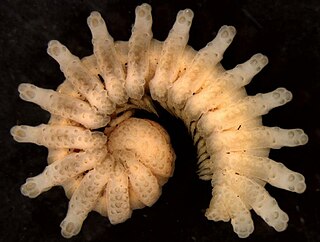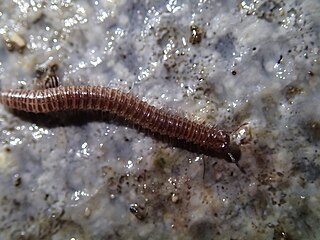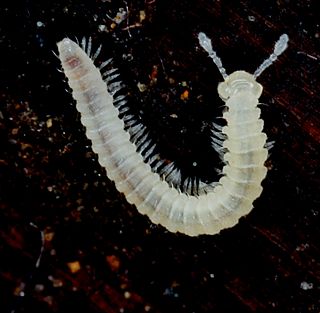
Polydesmida is the largest order of millipedes, with more than 5,000 species, including all the millipedes reported to produce hydrogen cyanide (HCN). This order is also the most diverse of the millipede orders in terms of morphology. Millipedes in this order are found in all regions of the world other than Antarctica.

Chordeumatida is a large order of millipedes containing more than 1,400 species. Also known as sausage millipedes, they are found nearly worldwide. Chordeumatida is the largest order in the superorder Nematophora, a group also known as spinning millipedes because their telsons feature spinnerets used to build nests of silk. These millipedes produce this silk to create chambers in which to molt or to lay their eggs.
Branneria is a genus of small millipedes in the order Chordeumatida and the only genus in the family Branneriidae. Individuals reach about 4 mm (0.16 in) long. There are two species known, found in the southeastern USA: Branneria bonoculus is found in Arkansas and eastern Texas while B. carinata occurs from North Carolina to Florida and Mississippi. The adult B. bonoculus millipede has 28 body segments, and the adult B. carinata millipede has 26, both fewer than the 30 usually found in the order Chordeumatida. In both species, the gonopod complex in adult males includes three leg pairs rather than just the two that are usually modified into gonopods in this order.

Haplodesmidae is a family of millipedes in the order Polydesmida. This family includes about 70 species. Species occur in East Asia, Southeast Asia, and Oceania, although some species have been introduced to the New world tropics.

Anthroleucosomatidae is a family of millipedes in the order Chordeumatida. This family includes more than 100 species distributed among 40 genera. This family has a mostly Holarctic distribution, with the greatest diversity in the area around the Mediterranean sea.
Caseyidae is a family of millipedes in the order Chordeumatida. Adult millipedes in this family have 30 segments. There are about 7 genera and at least 40 described species in Caseyidae.

Cleidogonidae is a family of millipedes in the order Chordeumatida. Adult millipedes in this family have 28, 29, or 30 segments. This family includes the genus Tianella, notable for featuring adult millipedes with 29 segments, a number not found in the adults of any other chordeumatidan species. Adults in most Tianella species have 29 segments, but adults in two have only 28 segments. In the Tianella species with 29 segments, adult females have 48 pairs of legs, as one would expect in adult female chordeumatidans with one segment fewer than the 30 usually found in this order. There are seven genera and at least 140 described species in Cleidogonidae.

Conotylidae is a family of millipedes in the order Chordeumatida. Adult millipedes in this family have 30 segments. There are about 19 genera and at least 60 described species in Conotylidae.

Striariidae is a family of millipedes in the order Chordeumatida. Adult millipedes in this family have 30 segments. There are at least 3 genera and about 13 described species in Striariidae.
Tingupidae is a family of millipedes in the order Chordeumatida. Adult millipedes in this family have 28 or 30 segments. There are 2 genera and 13 described species in Tingupidae.

Metopidiotrichidae is a family of millipedes in the order Chordeumatida. This family includes more than 70 species. These millipedes are found in Indochina, Australia, and on Pacific islands from New Zealand to Japan.
Speophilosomatidae is a family of millipedes belonging to the order Chordeumatida. These millipedes are found in Japan and range from 4 mm to 6 mm in length. Adult millipedes in this family are notable for being among the few in this order with only 26 segments instead of the 30 usually found in chordeumatidans. The adult males in this family are also notable for involving three leg pairs in the gonopod complex rather than the two pairs typically modified into gonopods in this order.
Peterjohnsiidae is a small family of millipedes belonging to the order Chordeumatida. The family was first described in 1987 by Jean-Paul Mauriès. These millipedes range from 3 mm to 8 mm in length and are found in Australia. Species in this family exhibit sexual dimorphism in segment number: adult males have 30 segments, but adult females have 32 segments. In adult males in this family, the gonopod complex involves three leg pairs rather than just the two usually modified into gonopods in this order.
Golovatchiidae is a family of millipedes belonging to the order Chordeumatida. This family contains a single species, Golovatchia magda. This species ranges from 15 mm to 17 mm in length and is found in the Russian Far East. Adult millipedes of this species have 30 segments. In the adult male of this species, the gonopod complex involves three leg pairs rather than just the two that are usually modified into gonopods this order.
Hoffmaneumatidae is a family of millipedes belonging to the order Chordeumatida. This family includes two genera, one (Hoffmaneuma) found in the Russian Far East and the other (Japanoparvus) found in Japan. Millipedes in this family range from 4 mm to 6 mm in length. Adult millipedes in this family have only 28 segments, not the 30 segments usually found in this order. Adult males in this family feature a reduced leg pair 10 in addition to the two pairs normally modified into gonopods in this order. In the adult male of the species Hoffmaneuma exiguum, for example, the gonopod complex derives from all three leg pairs rather than from just the usual two.
Kashmireumatidae is a small family of millipedes belonging to the order Chordeumatida. These millipedes range from 5mm to 14mm in length and are found in East Asia. Adult millipedes in this family have only 26 or 28 segments rather than the 30 segments usually found in this order. In the species Vieteuma topali, adults have 26 segments, whereas in all other species in this family, adults have 28 segments.
Haasea hungarica is a species of millipede in the family Haaseidae. This species is a eutroglophile, capable of spending its entire life cycle in a cave but also capable of living on the surface outside of caves. Although these millipedes are often found in caves, this species has also been found on the soil surface in forests.
Metamastigophorophyllon is a genus of millipedes in the family Anthroleucosomatidae. This genus includes millipedes found in Azerbaijan, Iran, Russia, and Georgia. All five species in this genus have 31 segments in adults. This genus is notable for including the only species in the order Chordeumatida with 31 segments rather than the 30 segments usually observed in adults in this order.
Neocambrisoma is a genus of millipedes in the family Metopidiotrichidae. Millipedes in this genus are found in Tasmania and New South Wales in Australia. Like other genera in this family, this genus features 32 segments in adults of both sexes, rather than the 30 segments usually observed in adults in the order Chordeumatida. Accordingly, female adults in this genus have 54 pairs of legs, which is not only the maximum number observed in this order but also the maximum number fixed by species in the class Diplopoda.
Neocambrisoma raveni is a species of millipede in the family Metopidiotrichidae. These millipedes are found in New South Wales in Australia. Like other species in this family, N. raveni features 32 segments in adults of both sexes, rather than the 30 segments usually observed in adults in the order Chordeumatida. Accordingly, adult females of this species have 54 pairs of legs, which is not only the maximum number observed in this order but also the maximum number fixed by species in the class Diplopoda.







